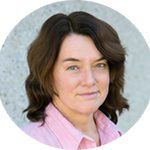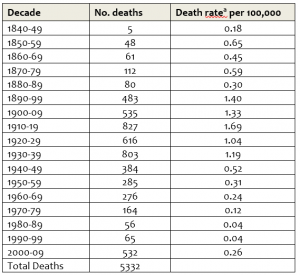The heat is on: but we’ve been there before
Sydney was the hottest city on earth on Sunday 7 January 2018 (and no, I’m not talking about its nightlife) when Penrith, in the outer west, reached 47.30C, pipping its previous record set on 11 February 2017 (News Limited, 2018).
But if you want really hot, then travel back in time to 1939, when the Old Richmond Station set Sydney’s official heat record at 47.80C. Yes, we’ve had heatwaves before. Way before.
The table below shows numbers of deaths and death rates per 100,000 population from episodes of extreme heat in Australia by decade between 1844 and 2010, as recorded in Risk Frontiers’ PerilAUS database (after Coates et al. (2013)). PerilAUS is a resource of natural hazard event impacts reaching back to the early days of Australia’s European settlement. The death rate is the number of deaths per head of population in the country at that time, and was consistently significantly higher between 1890 and 1939 than for any period before or since.
Of all of the entrIes in the Table, the January 1939 event was notable for its longevity and record daily temperature maxima. Victoria and South Australia, as well as country NSW, were affected with Melbourne reaching a high of 45.60C and Adelaide 46.10C. In NSW, Bourke suffered through 37 consecutive days over 380C.
PerilAUS records show that at least 420 people died in the 1939 event across Australia, most (77%) in NSW. The series of heatwaves were accompanied by strong northerly winds, and followed a very dry six months. This led to the disastrous Black Friday bushfires in Victoria, which killed 71 people.
Most will remember the catastrophic bushfires that destroyed several towns in Victoria in 2009 but not many will remember that these fires also followed two heatwave events across Victoria and SA, where at least 432 people died.
This figure comprises mainly a measure of excess deaths rather than recorded individual deaths. An excess death is a premature death and, in this context, a measure of the number of deaths occurring over and above that expected for that location and time of year.
In 2009, new records of three consecutive days over 430C in Melbourne and eight over 400C in Adelaide were set. A feature of these heatwaves was the very hot minimum temperatures, with Melbourne’s temperature falling to between 20-250C overnight and Adelaide to just 300C.
A similar death toll resulted from the heatwave that occurred from October 1895 to January 1896 that impacted nearly the entire continent but especially the interior. PerilAUS records 435 deaths, 89% of them within NSW. Deaths also occurred in SA, WA, Victoria and Queensland. Bourke, in NSW, lost 1.6% of its population to the heat: temperatures of 400C in the shade were already being recorded in October, mid-Spring.
Heatwaves in Australia, including catastrophic ones, are not new. Risk Frontiers first noted the fact that they are Australia’s number one natural hazard killer more than two decades ago (Coates, 1996). For further reading on this important natural hazard, the reader is referred to Coates et al. (2013).
References
Coates L, 1996, An Overview of Fatalities from Some Natural Hazards, Proceedings, NDR96 Conference on Natural Disaster Reduction, 29 September-2 October 1996, Gold Coast, ed. R L Heathcote, C Cuttler and J Koetz. 49-54 http://search.informit.com.au/documentSummary;dn=547566533577889;res=IELENG
Coates L, Haynes, K, O’Brien, J, McAneney, J and Dimer de Oliveira, F, 2014, Exploring 167 years of vulnerability: An examination of extreme heat events in Australia 1844-2010, Environmental Science & Policy, 42:33-44. http://www.sciencedirect.com/science/article/pii/S1462901114000999
News Limited, 2018 – news.com.au [Daily Telegraph, 8 January 2018, originally published as Sydney: The hottest place on Earth], NSW heatwave: Sydney the hottest place on Earth, http://www.news.com.au/technology/environment/nsw-heatwave-sydney-the-hottest-place-on-earth/news-story/0486ad5df9b5025ac24a4507aa1b8a17, accessed 8/1/2018
About the author/s

Lucinda Coates
Lucinda is a Senior Research Consultant at Risk Frontiers. With over 30 years in the natural hazards field, she specialises in the impacts of and vulnerability vs resilience to hazard events. Highly experienced in data analysis, Lucinda also manages PerilAUS, an Australian database of hazard impacts.

